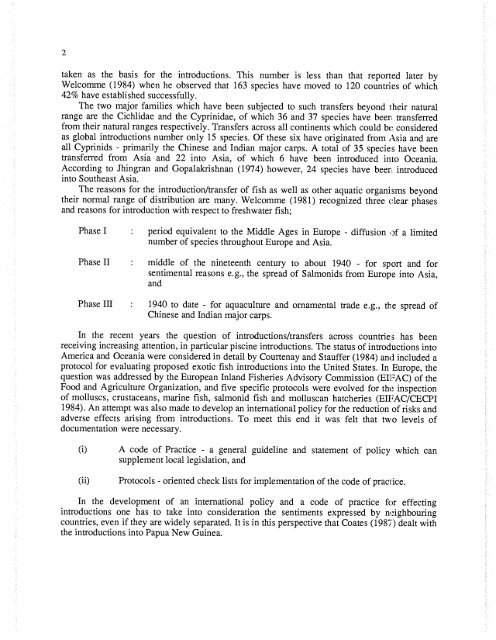Exotic Aquatic Organisms - International Development Research ...
Exotic Aquatic Organisms - International Development Research ...
Exotic Aquatic Organisms - International Development Research ...
Create successful ePaper yourself
Turn your PDF publications into a flip-book with our unique Google optimized e-Paper software.
2<br />
taken as the basis for the introductions. This number is less than that reported later by<br />
Welconime (1984) when he observed that 163 species have moved to 120 countries of which<br />
42% have established successfully.<br />
The two major families which have been subjected to such transfers beyond their natural<br />
range are the Cichlidae and the Cyprinidae, of which 36 and 37 species have been transferred<br />
from their natural ranges respectively. Transfers across all continents which could be considered<br />
as global introductions number only 15 species. Of these six have originated from Asia and are<br />
all Cyprinids - primarily the Chinese and Indian major carps. A total of 35 species have been<br />
transferred from Asia and 22 into Asia, of which 6 have been introduced into Oceania.<br />
According to Jhingran and Gopalakrishnan (1974) however, 24 species have been introduced<br />
into Southeast Asia.<br />
The reasons for the introduction/transfer of fish as well as other aquatic organisms beyond<br />
their normal range of distribution are many. Welcomme (1981) recognized three clear phases<br />
and reasons for introduction with respect to freshwater fish;<br />
Phase I<br />
Phase II<br />
period equivalent to the Middle Ages in Europe - diffusion of a limited<br />
number of species throughout Europe and Asia.<br />
middle of the nineteenth century to about 1940 - for sport and for<br />
sentimental reasons e.g., the spread of Salmonids from Europe into Asia,<br />
and<br />
Phase III : 1940 to date - for aquaculture and ornamental trade e.g., the spread of<br />
Chinese and Indian major carps.<br />
In the recent years the question of introductions/transfers across countries has been<br />
receiving increasing attention, in particular piscine introductions. The status of introductions into<br />
America and Oceania were considered in detail by Courtenay and Stauffer (1984) and included a<br />
protocol for evaluating proposed exotic fish introductions into the United States. In Europe, the<br />
question was addressed by the European Inland Fisheries Advisory Commission (EIPAC) of the<br />
Food and Agriculture Organization, and five specific protocols were evolved for the inspection<br />
of molluscs, crustaceans, marine fish, salmonid fish and molluscan hatcheries (EIFAC/CECPI<br />
1984). An attempt was also made to develop an international policy for the reduction of risks and<br />
adverse effects arising from introductions. To meet this end it was felt that two levels of<br />
documentation were necessary.<br />
A code of Practice - a general guideline and statement of policy which can<br />
supplement local legislation, and<br />
Protocols - oriented check lists for implementation of the code of pracl;ice.<br />
In the development of an international policy and a code of practice for effecting<br />
introductions one has to take into consideration the sentiments expressed by neighbouring<br />
countries, even if they are widely separated. It is in this perspective that Coates (1987) dealt with<br />
the introductions into Papua New Guinea.

















